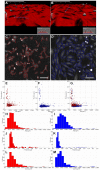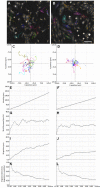A Time-lapse, Label-free, Quantitative Phase Imaging Study of Dormant and Active Human Cancer Cells
- PMID: 29553530
- PMCID: PMC5931278
- DOI: 10.3791/57035
A Time-lapse, Label-free, Quantitative Phase Imaging Study of Dormant and Active Human Cancer Cells
Abstract
The acquisition of the angiogenic phenotype is an essential component of the escape from tumor dormancy. Although several classic in vitro assays (e.g., proliferation, migration, and others) and in vivo models have been developed to investigate and characterize angiogenic and non-angiogenic cell phenotypes, these methods are time and labor intensive, and often require expensive reagents and instruments, as well as significant expertise. In a recent study, we used a novel quantitative phase imaging (QPI) technique to conduct time-lapse and labeling-free characterizations of angiogenic and non-angiogenic human osteosarcoma KHOS cells. A panel of cellular parameters, including cell morphology, proliferation, and motility, were quantitatively measured and analyzed using QPI. This novel and quantitative approach provides the opportunity to continuously and non-invasively study relevant cellular processes, behaviors, and characteristics of cancer cells and other cell types in a simple and integrated manner. This report describes our experimental protocol, including cell preparation, QPI acquisition, and data analysis.
References
-
- Folkman J. Angiogenesis in cancer, vascular, rheumatoid and other disease. Nature Medicine. 1995;1(1):27–31. - PubMed
-
- Hanahan D, Folkman J. Patterns and emerging mechanisms of the angiogenic switch during tumorigenesis. Cell. 1996;86(3):353–364. - PubMed
-
- Harper J, Moses MA. Molecular regulation of tumor angiogenesis: mechanisms and therapeutic implications. EXS. 2006. pp. 223–268. - PubMed
-
- Naumov GN, et al. A model of human tumor dormancy: an angiogenic switch from the nonangiogenic phenotype. Journal of the National Cancer Institute. 2006;98(5):316–325. - PubMed
Publication types
MeSH terms
LinkOut - more resources
Full Text Sources
Other Literature Sources




